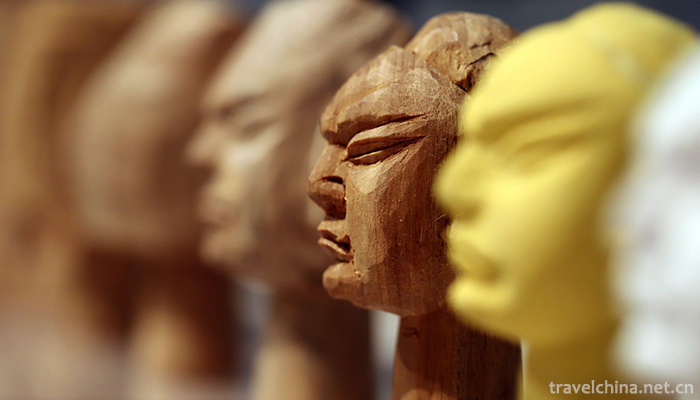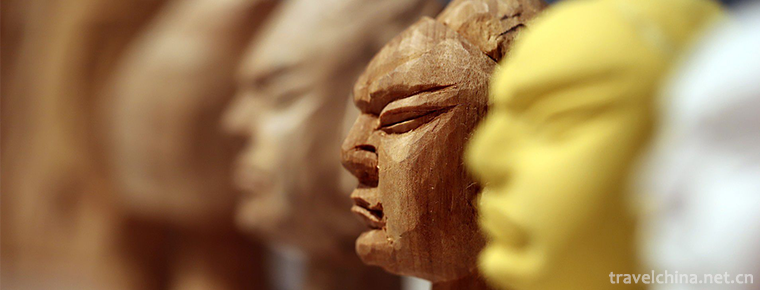Puppet Head Sculpture
Puppet Head Sculpture
Zhangzhou puppet head carving is a traditional folk arts and crafts in Zhangzhou City, Fujian Province. It belongs to a special skill in the production of puppet stage props. Zhangzhou puppet head carving mainly distributes in Zhangzhou City, Xiamen City, Quanzhou City and surrounding areas of Fujian Province. The overall shape of Zhangzhou puppet includes head, limbs, clothing, helmet and so on. Puppet head carving only refers to head shape. As the sculpture of personage head in opera stage, it pays great attention to the characterization of personage's personality. The exaggerated shape, rich expression and typification are the common characteristics of Zhangzhou puppet head sculpture. This sculpture has always been handed down by teachers and apprentices, and is mainly handed down by family ancestors. It has been handed down uninterruptedly till now.
On May 20, 2006, Zhangzhou puppet head carving was approved by the State Council to be included in the first batch of national intangible cultural heritage list.
Historical Origin
Zhangzhou puppet carving began in Jin Dynasty and flourished in Tang Dynasty. It has a history of nearly two thousand years. Folk artists Xu Niansong and Xu Shengfang's puppet works were collected by art and craft departments after the founding of New China. In 1959, Xu Niansong's carved puppet heads of Shengdan and Dandan were selected to participate in the national arts and crafts exhibition and were well received by the cultural and art circles. Xu Zhuchu, Xu's son, inherited and innovated. From 1979 to 1989, his works were exhibited in Australia, the United States, Taiwan and Hong Kong and won a high reputation. Xu Zhuchu's representative works of puppet heads are treasured in Zhuchu Puppet Art Museum on the second floor of Garden Building, Yan'an North Road in the urban area.
Since the Ming and Qing Dynasties, puppet shows have gradually evolved from cities to towns, and formed puppet plastic arts of different styles and schools. For example, in Quanzhou Jiali Opera in Fujian Province, there are only four actors, Sheng, Dan, Bei (Jing), Za (Ugly), which are called "Four Beautiful Classes". Some Jiali operas have only 36 images, so they are called "36 Jiali as a million soldiers". Quanzhou's early famous puppet head sculptor, the idol shop and puppet craftsmen in Yiquan Backstreet, Huang Liangsi and Huang Caisi in Tumen Street, and later Huang Jiaxiang and Jiang Jiagao, the puppet sculptor in Beimen Garden Street. Their puppet sculpture, exquisite sculpture, rich face, with the characteristics of figures in the Tang Dynasty; meticulous pastel, bright lines, forming a Southern Fujian puppet model. The puppet puppet show of Zhangzhou in Longxi area was very popular in Qing Dynasty. Xu Ziqing, a puppet sculptor, was very popular in the twelve years of Jiaqing in the Qing Dynasty. Xu Ziqing, a puppet sculptor, opened Chengcheng Shi Puppet Workshop in Dongmen of Zhangzhou in the twelfth year of Jiaqing in the Qing Dynasty (1807). Xu Niansong, a puppet sculptor known as "Nanjiang (Jiagou) Beixu", is the representative of the Beijie School. By the beginning of Xu Zhuchu's generation, it has been the sixth generation.
Inheritance Significance
It has a broader social mass base.
Puppet show in southern Fujian has a relatively broad social mass base, and the plastic arts of puppet heads have also gained a deep foundation for development. The art of puppet head sculpture is closely related to traditional opera. In the situation of the general decline of opera performance, the inheritance of puppet head sculpture technology also encounters difficulties: if we stick to the stage, puppet head sculpture can only go silent with the opera; if we leave the stage, puppet head sculpture can only become a simple ornament, and many of the living culture of its traditional skills will be lost. At present, Zhangzhou puppet head carving is facing such a situation, which needs the attention of relevant parties.
Facing the danger of "extinction"
As a traditional folk art, Zhangzhou's puppet carving has always followed the ancient system of inheriting men from women. In the contemporary era, most of the descendants of old artists are reluctant to learn puppet carving, because this skill is time-consuming, laborious and economically unproductive, and many old artists have to change careers. This national treasure is facing the danger of "extinction" because nobody succeeds.
Listed in the First National List of Non-material Cultural Heritage
The state attaches great importance to the protection of intangible cultural heritage. On May 20, 2006, the intangible cultural heritage was approved by the State Council and listed in the first batch of national intangible cultural heritage list. On June 5, 2007, Xu Zhuchu and Xu Congliang in Zhangzhou City, Fujian Province, were confirmed by the Ministry of Culture as the representative successors of the cultural heritage projects, and were listed in the first batch of 226 representative successors of the national intangible cultural heritage projects.


-
1.Qiqu Mountain Scenic Area
Qiqu Mountain Scenic Spot is located about 9 kilometers north of Zitong County, Mianyang City, Sichuan Province. It is located at the southern end of Jianmen Shudao Scenic Spot.
Time 2018-12-17 -
2.Guanmenshan National Forest Park
Guanmenshan National Forest Park is located 70 kilometers southeast of Benxi City. The Forest Park covers an area of 3517 hectares, with an altitude of 310-1234 meters and a forest coverage
Time 2018-12-24 -
3.Nanjiang Grand Canyon
Nanjiang Grand Canyon is located in Kaiyang County in the middle of Guizhou Plateau, 54 kilometers away from Guiyang, the capital of Guizhou Province
Time 2018-12-31 -
4.Ming Xiaoling Mausoleum
The Ming Xiaoling Tomb is situated at the south foot of Zijinshan Mountain in Xuanwu District, Nanjing, under Dulongfu Playing Pearl Peak. It is adjacent to Zhongshan Tomb in the East
Time 2019-02-07 -
5.Ancient town of Tangqi
Tangqi Town, located in the northern part of Hangzhou City, borders Deqing County of Huzhou City, is about 20 kilometers away from the city centre and 13 kilometers away from Linping
Time 2019-02-13 -
6.Gaoyou folk songs
The earliest source of Gaoyou folk songs can be traced back to the Neolithic Age. Gaoyou Lake and Lixia River in Gaoyou City are the traditional folk songs widely spread in their production and life.
Time 2019-04-30 -
7.Music of Lantian Puhua Water Club
Lantian Puhua Water Concert Music is a kind of folk blowing music which has been circulated in Puhua Town of Lantian County, Shaanxi Province for more than 1000 years
Time 2019-05-11 -
8.Quanzhou North Pipe
Beiguan, also known as Beiqu, Xiaoqu, Quzi, is a kind of traditional folk silk and bamboo music widely spread in Quangang District, Quanzhou City, Fujian Province. China's Beiguan is now only distribu
Time 2019-06-11 -
9.Uygur Sainem
Among the numerous traditional folk dances, "Sainem" is the most common form of Uygur folk song and dance. It is widely spread in the towns and villages in the north and south of Tianshan Mo
Time 2019-06-27 -
10.Legend of Dayu
Dayu's water control is a great project in the ancient times of our country. It once benefited mankind and became a symbol of the strength and wisdom of the ancient people of our country. Until the Sp
Time 2019-07-16 -
11.Population and nationality of Suining
At the end of 2019, the total number of household registration in Suining was 1 million 380 thousand, and the household registration population was 3 million 629 thousand, a decrease of 0.7% over the previous year, of which 1 million 4 thousand and 900
Time 2020-12-16 -
12.Meishan primary industry
In 2019, the total sown area of crops is 318000 hectares, an increase of 1.1%. Among them, the planting area of grain crops was 196000 hectares, an increase of 0.6%; the planting area of oil crops was 58000 hectares, an increase of 1.8%; the planting area
Time 2020-12-18